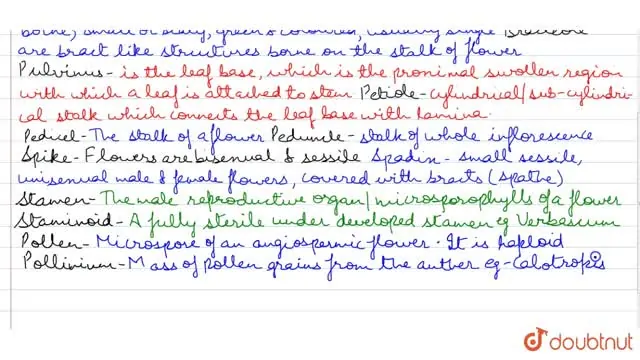Differentiate between
(a) Bract and bracteole (b) Pulvinus and petiole
(c) Pedicel and peduncle (d) Spike and spadix
(e)Stamen and straminoid (f) Pollen and pollenium
(a) Bract and Bracteolate Bract is a leaf like structure in the axil. i.e., at the base of which flowers are borne. They can be small or scaly, grreen and coloured and usually single, whereas bracteolate are bract like structures borne on the stalk of a flower
(b) Pulvinus and petiole Pulvinus is the leaf base, which is the proximal swollen region with which a leaf is attached to the stem. Petiole is cylindrical or sub-cylindrical stalk which connects the leaf base with the lamina.
(c) Pedical and Peduncle The stalk of a lower as pedicle , whereas the stalk of whole inflorescence is known as peduncle.
Spike and Spadix in spike inflorescence , the flowers are sessile that develop on an elongated peduncle in acropetal succession e.g. , Adhatoda. The peduncle is non-flesly. The spadix inflorescence si like spike, but it is covered by one to a few large bracts called spathes e.g., Colocasia. The peduncle is fleshy and its opical portion is naked ,i.e., without flowers.
Stamen and Staminoid The male reproductive organs or microporophylls of a flower are called stamen. A fully sterile under developed or abrtive stamen is called a staminoid e.g., Verbascum.
Pollen and Pollinium Microspore of an angiospermic flower is known as pollen. It is haploid, whereas a mass of pollen grains from the anther constitue the pollinium as in Calotropis.
Related Playlists
- BOOK - NCERT EXEMPLARCHAPTER - MORPHOLOGY OF FLOWERING PLANTSEXERCISE - Long Answer Type Questions8videos
MORPHOLOGY OF FLOWERING PLANTS
- BOOK - NCERT EXEMPLARCHAPTER - MORPHOLOGY OF FLOWERING PLANTSEXERCISE - Very Short Answer Type Questions10videos
MORPHOLOGY OF FLOWERING PLANTS
- BOOK - NCERT EXEMPLARCHAPTER - MINERAL NUTRITIONEXERCISE - Long Answer Type Questions8videos
MINERAL NUTRITION
- BOOK - NCERT EXEMPLARCHAPTER - NEURAL CONTROL AND CO-ORDINATIONEXERCISE - LONG ANSWER TYPE QUESTIONS3videos
NEURAL CONTROL AND CO-ORDINATION
Similar Questions
Differentiate between
(a) Bract and Bracteole
(b) Pulvinus and petiole
(c) Pedicel and peduncle
(d) Spike and spadix
(e) Stamen and staminode
(f) Pollen and polliniumView SolutionDifferentiate between :
(a) Myelinated and non-myelinated axons (b) Dendrites and axons
(c ) Rods and cones (d) Thalamus and Hypothalamus
(e ) Cerebrum and CerebellumView SolutionDifferentiate between the following:
(a) Diffusion and Osmosis
(b) Transpiration and Evaporation
(c) Osmotic Pressure and Osmotic Potential
(d) Imbibition and Diffusion
(e) Apoplast and Symplast pathways of movement of water in plants.
(f) Guttation and Transpiration.View Solution(a) Differentiate between nuclear fission and nuclear fusion.
(b) Which of the two, nuclear fission and nuclear fusion, is made use of :
(i) for the production of electricity ?
(ii) for making a hydrogen bomb ?
(c ) Which produces more energy : nuclear fusion or nuclear fission ?
(d) Calculate the energy released in joules when 5 g of a material is completely converted into energy during a nuclear reaction.
(e) How much is this energy in MeV ? (Speed of light = 3×108m/s)View SolutionHow will you differentiate the following? A) Ethylene and ethane
b) Ethylene and acetylene
c) Ethane and ethyne
d) But-1-ene and but-1-yne
e) But-2-yne and but-1-yneView SolutionDifferentiate between Monera and Protista based based upon the following characters :
(a) Chemical nature of cell wall
(b) Location of respiratory apparatus
(c ) Types of cytoplasmic ribosome
(d) Genetic meterial
(e) Location of extrachromosomal DNA.View SolutionFind the differentiation of eaxcos(bx+c) w.r.t. x
View SolutionDifferentiate the following functions with respect to x ax2+bx3−cosecx+tanx
View Solution(a). State any three differences between the physical properties of metals and non-metals.
(b). Differentiate between metals and non-metals on the basis of their chemical properties.
(c). State three reasons (of which at least one must be chemical) for believing that sodium is a metal.
(d). State three reasons (of which at least one must be chemical) for believing that sulphur is a non-metal.
(e). Which non-metal has been placed in the reactivity series of metals.View SolutionIf a, b, c, d, e, f are A.M's between 2 and 12, then a + b + c + d + e + f is equal to
View Solution


